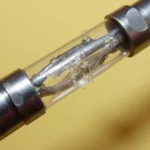Rust, stemming from a seemingly insignificant car paint chip, can quickly escalate into a major problem. Ignoring car paint chip rust repair can lead to costly bodywork down the line. This guide provides everything you need to know about identifying, preventing, and tackling this common car issue.
Dealing with rust from a paint chip is more than just a cosmetic fix; it’s about protecting your car’s structural integrity. Left unchecked, rust can spread, weakening the metal and compromising safety. Understanding the process of car paint chip rust repair empowers you to take control and preserve your vehicle’s value and longevity. Want to learn more about handling paint chips before they turn into rust nightmares? Check out our guide on how to repair a paint chip rust on car.
Understanding the Enemy: Why Car Paint Chips Rust
A paint chip exposes the underlying metal to the elements, primarily moisture and oxygen. This sets the stage for oxidation, the chemical reaction that produces rust. Road salt accelerates this process, making winter a particularly vulnerable time for your car’s paint. Various factors contribute to paint chips, including road debris, stone impacts, and even minor scrapes in parking lots.
Identifying Rust in its Early Stages
Early detection is crucial for effective car paint chip rust repair. Look for small, reddish-brown spots, often bubbling or flaking. If you catch the rust early, a simple DIY repair might suffice. However, more extensive rust may require professional intervention. Do you know what tools and materials are needed for efficient repairs? Learn more about a comprehensive car paint chip repair system.
DIY Car Paint Chip Rust Repair: A Step-by-Step Guide
For minor rust spots, you can perform the repair yourself. Here’s a simplified guide:
- Clean the Area: Thoroughly clean the chipped area with soap and water, then dry it completely.
- Remove the Rust: Use a rust remover or fine-grit sandpaper to carefully remove all traces of rust.
- Apply Primer: Apply a thin coat of automotive primer to the bare metal to protect it and provide a good surface for the paint.
- Apply Touch-Up Paint: Carefully apply touch-up paint that matches your car’s color. Multiple thin coats are better than one thick coat.
- Apply Clear Coat (Optional): For added protection and a glossy finish, apply a clear coat once the touch-up paint is dry.
If you’re looking for professional car paint repair services, especially for specific car brands, you might find our guide on Audi car paint repair helpful.
Preventing Future Paint Chips and Rust
Prevention is always better than cure. Here are some tips to protect your car’s paint:
- Regular Washing and Waxing: Regular washing removes dirt and grime that can scratch the paint, while waxing provides a protective layer.
- Touch-Up Chips Promptly: Addressing paint chips as soon as they occur prevents rust from developing.
- Park Carefully: Avoid parking in areas prone to debris or where your car might get scratched.
- Use a Car Cover: A car cover provides excellent protection against the elements, including UV rays, rain, and snow.
“Regular maintenance is key,” says John Miller, a veteran auto body technician. “Addressing small paint chips immediately can save you a lot of time and money in the long run.”
When to Call a Professional
While minor rust can be addressed with DIY methods, more extensive rust requires professional expertise. If the rust has penetrated deep into the metal or has spread significantly, it’s best to consult a qualified auto body shop. They have the tools and expertise to handle complex rust repairs effectively. Do you need advice on how to approach car paint repairs in general? Check out our guide on how to car paint repair.
Conclusion
Car paint chip rust repair is essential for maintaining your vehicle’s appearance, value, and structural integrity. By understanding the causes of rust and taking preventative measures, you can protect your car from this common problem. Whether you opt for a DIY approach or seek professional help, addressing car paint chip rust promptly is crucial for preventing further damage and preserving your car’s longevity. If you’re looking for reliable car paint repair services in Gravesend, take a look at car paint repair Gravesend.
FAQ
- Can I use any type of primer for car paint chip rust repair? No, use automotive primer specifically designed for metal.
- How long does touch-up paint take to dry? Drying times vary, so follow the instructions on the paint product.
- Is it necessary to apply a clear coat after touch-up paint? A clear coat provides added protection and a glossy finish but is optional.
- What if the rust comes back after repair? If rust reappears, it might indicate a more significant underlying issue, and you should consult a professional.
- How often should I wax my car? Waxing every three to six months is generally recommended.
- Can I prevent rust from forming on existing paint chips? Yes, by cleaning the chip and applying touch-up paint promptly.
- What’s the best way to remove rust from a car? This depends on the severity. For minor surface rust, sandpaper or a rust remover can be used. For more serious rust, professional blasting or chemical removal may be necessary.
Other Situations and Questions
What if the rust is on a difficult-to-reach area like under the car? How do you deal with rust on chrome trim? These are common questions and we have resources to help.
Further Reading
Explore other related articles on our website for more in-depth information on car maintenance and repair:
- How to repair a dent in your car
- Choosing the right car wax for your vehicle
- Understanding different types of car paint
Need help? Contact us via WhatsApp: +1(641)206-8880, Email: [email protected]. We have a 24/7 customer support team.

